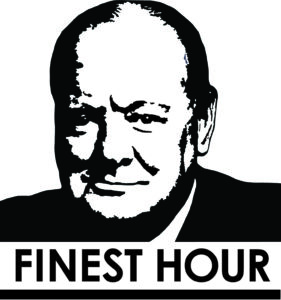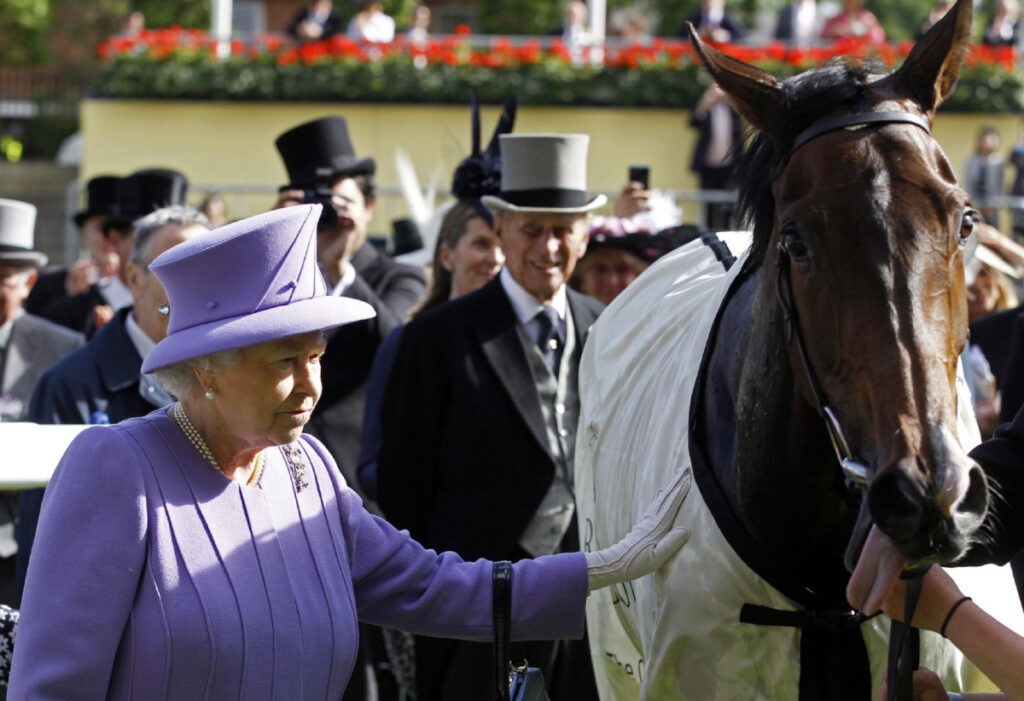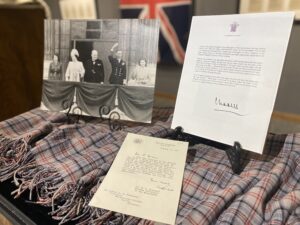
Finest Hour 199
“The Excitement and Liveliness of the Turf”

The Queen and Prince Philip at Royal Ascot
April 20, 2024
Queen Elizabeth II, Winston Churchill, and Horse Racing
Finest Hour 199, Special Issue 2022
Page 16
By Fred Glueckstein
Fred Glueckstein is author of Churchill and Colonist II (2014)
Queen Elizabeth II and Winston Churchill had a profound and enduring friendship. Each had a great fondness for horse racing, the sport of kings. Churchill had trained as a cavalry officer at Sandhurst in the days of the Queen’s great-great-grandmother, Queen Victoria. He became an avid polo player and twice rode into combat in the saddle, once in India and once in Africa. Not until after the Second World War, however, when he was Leader of the Opposition, did Churchill become an owner of racehorses.
This new preoccupation gave Churchill something in common with the Royal Family and led to a new bond between the royals and the former prime minister. Prior to her ascending the throne, Princess Elizabeth invited the eminent political leader to a luncheon at Hurst Park racecourse in Surrey before the running of the Winston Churchill Stakes on Saturday, 14 May 1951.
The Winston Churchill Stakes was run at a distance of just over one mile. Churchill’s first thoroughbred racehorse, a five-year-old grey named Colonist II, was one of the runners. Also running was His Majesty King George VI’s black filly Above Board, for which Princess Elizabeth had high regard. Five other challengers included Cantarello II, Fast Fox, Selskar Abbot, Star Spangled Banner, and Tourette.

2024 International Churchill Conference
Despite a cold and dreary afternoon, a large crowd was at Hurst Park. At 3:46 pm the thoroughbreds bolted from the starter’s gate and thundered down the turf. Wearing Churchill’s racing colors, pink with chocolate sleeves and cap, jockey Tommy Gosling and Colonist II took the lead and were in front of the field halfway up the straight.
As the field raced around the course, Colonist II led at the turn. Charging hard was His Majesty’s filly Above Board with W. H. Carr in the saddle. Carr wore the Royal Colors of purple with scarlet sleeves and a black cap with gold tassel. Heading for the winning post, Colonist II was still in the lead, galloping with determination and confidence. Amidst the boisterous cheering of the racegoers, Churchill’s grey came in first, two lengths ahead of Above Board, with Star Spangled Banner, a black colt, placing third.¹
That evening, the King sent a telegram from Balmoral Castle to Churchill: “Many congratulations on your win.” Churchill replied: “I am deeply grateful for your Majesty’s most kind and gracious telegram.”²
Churchill also wrote a letter to Princess Elizabeth on 20 May. He thanked her for asking him to lunch at Hurst Park the prior Saturday and for the gracious congratulations with which she honored him. Churchill added: “I wish indeed that we could both have been victorious—but that would be no foundation for the excitement and liveliness of the Turf.”³

The Rematch
Two weeks after Colonist II and Above Board first met, they faced each other again on 27 May in the White Rose Stakes at Hurst Park. The race was run at a distance of a little more than a mile. Princess Elizabeth and Churchill were once again friendly horse racing competitors.
Although it looked like Above Board and another challenger named Pan II could catch and pass Colonist II, the grey and his jockey Gosling pulled away at the end. Galloping across the winning post, Churchill’s colt finished ahead of Pan II and Above Board, respectively.⁴
Princess Elizabeth and Churchill each had a genuine appreciation for horse racing. For Churchill it became part of his life, and, despite his busy schedule, he found time to watch Colonist II run. Typical was 4 June 1951, when Churchill left his home at Chartwell for London, saw Colonist II run at Kempton Park racecourse the next day, and dined at Buckingham Palace that night. One must assume that Churchill and Princess Elizabeth discussed Colonist II’s performance that day.
After Colonist II and Gosling had won the Jockey Club Cup on 26 October 1950, the racing journals lauded Colonist II and his owner. One racing journal wrote that the season would certainly go down in history as Colonist II’s because the tough and determined grey horse had performed miracles. The journal went on to say that no horse in living memory had put up such a sequence of wins in good-class races in one season.
It was further pointed out that Colonist II had achieved eight wins (six in succession, ending with the Jockey Club Cup), once second, and twice fourth in eleven races. Colonist II “reads like something inspired, and that in truth, was just what this horse seemed to be, by the great spirit of his indefatigable owner.”⁵ Princess Elizabeth would have been in total agreement.
On 21 July 1951, Colonist II was at Ascot racing in the richest race ever run in Britain, the $84,000 Festival of Britain Stakes, run at a mile and a half. The King and Queen put up part of the stake money. As a five-year-old, Colonist II was the oldest entry in a crowded field of nineteen.
Churchill saw the race, as did Queen Elizabeth and Princess Elizabeth. Mrs. Vera Lilley’s three-year-old Supreme Court, at 100- to-9, finished first. Colonist II, with Gosling again in the saddle, came on a quarter of a mile from home and finished fourth.⁶
Prime Minister Again
On 25 October 1951, the Conservatives defeated Labour in a narrow general-election victory, and Winston Churchill became Prime Minister for the second time. Although Churchill once again bore the demanding duties of high office, he still found time to watch his horses. Churchill regularly discussed his equestrian interests with his son-in-law Christopher Soames, veterinarian Anthony Foster-Carey, and horse trainer Walter Nightingall.
When Nightingall suggested that Churchill put Colonist II out to stud, Churchill vetoed the idea, allegedly by saying: “To stud? And have it said that the Prime Minister of Great Britain is living on the immoral earnings of a horse?”⁷ While it is unknown whether Princess Elizabeth heard Churchill’s comment, most likely she would have found it extremely amusing.
At the first anniversary of Queen Elizabeth’s coronation, she celebrated by going to the racecourse to cheer on her outstanding brown colt, Landau. It was reported that Prime Minister Churchill cut short a Cabinet meeting so that he and his ministers could join her.⁸
Newchapel Stud
In May 1955, Churchill bought Newchapel Stud, a forty-two acre farm in Surrey, where he and Christopher Soames embarked on a breeding program.⁹ Altogether, Churchill owned twelve brood mares and thirty-eight thoroughbreds. Among Churchill’s great breeding successes at Newchapel was Colonist II’s half-brother, Le Pretendant. On 28 February 1958, Queen Elizabeth and Princess Margaret watched the horse win the Ashford novices’ hurdle race by twenty lengths at Kempton Park.
Another of Churchill’s well-known racehorses was Vienna. The thoroughbred was foaled in 1957 out of Churchill’s brood mare Turkish Blood, sired by Queen Elizabeth’s Aureole. Aureole, a racehorse bred by King George VI, was the first horse the Queen inherited from her late father.
Aureole’s career lasted from August 1952 until July 1954. During that time, he ran fourteen times and won eleven races. At his peak in 1954 he won, as his last race, Britain’s most prestigious race, the King George VI and Queen Elizabeth Stakes.
In celebration of the Queen’s Platinum Jubilee, forty jockeys past and present gathered in the Queen’s distinctive purple and red colors to form a guard of honor for Her Majesty at the Derby run at Epsom Racecourse. Without question, Sir Winston would have appreciated the pageantry honoring the Queen at the famous racecourse and enjoyed watching the race with Her Majesty at Epsom.
Endnotes
1. Fred Glueckstein, Churchill and Colonist II: The Story of Winston Churchill and His Famous Race Horse (Bloomington, IN: iUniverse, 2014), p 2.
2. Martin Gilbert, Winston S. Churchill, vol. VII, Never Despair, 1945–1965 (Boston: Houghton Mifflin, 1988), p. 563.
3. Ibid., p. 613.
4. Glueckstein, p. 49.
5. Gilbert, p. 563, n 2.
6. Glueckstein, p. 53.
7. Gilbert, p. 488, n. 2.
8. “Sport: The Show at Epsom Downs,” Time, 14 June 1954.
9. Glueckstein, p. 69.
Subscribe
WANT MORE?
Get the Churchill Bulletin delivered to your inbox once a month.




